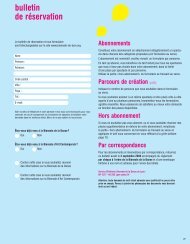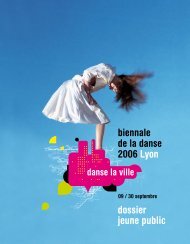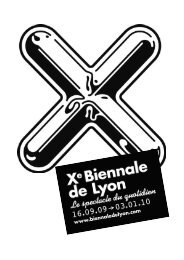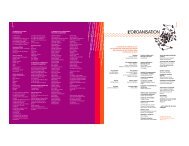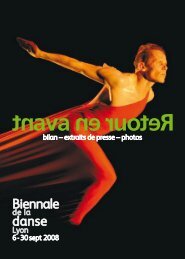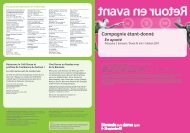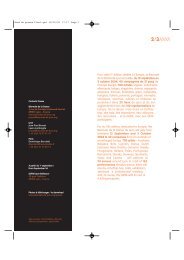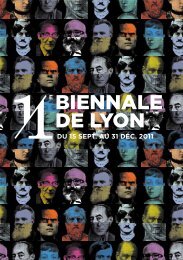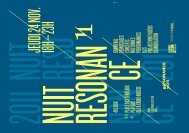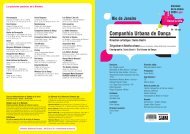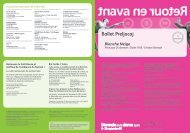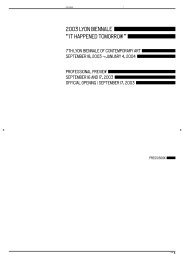Kubi<strong>la</strong>ï Khan InvestigationsCréation 2008Direction artistique : Frank MichelettiScénographie et lumières : Ivan MathisCoproduction : Bi<strong>en</strong>nale <strong>de</strong> <strong>la</strong> <strong>Danse</strong> <strong>de</strong> <strong>Lyon</strong>, l’Ars<strong>en</strong>al (Metz), La Comédie <strong>de</strong> Clermont-Ferrand - Scène Nationale, Théâtres <strong>en</strong> Dracénie, CNCDC <strong>de</strong> Châteauvallon, Théâtre Louis Aragon (Tremb<strong>la</strong>y<strong>en</strong>-<strong>France</strong>),le Po<strong>la</strong>ris (Corbas) - Créé <strong>en</strong> résid<strong>en</strong>ce à Châteauvallon, avec le souti<strong>en</strong> du CNCDC - Kubi<strong>la</strong>ï Khan Investigations est conv<strong>en</strong>tionnée par le Ministère <strong>de</strong> <strong>la</strong> culture et <strong>de</strong> <strong>la</strong> communication- DRAC Prov<strong>en</strong>ce-Alpes-Côte d’Azur et par <strong>la</strong> Région Prov<strong>en</strong>ce-Alpes-Côte d’Azur et subv<strong>en</strong>tionnée par le Conseil Général du Var et <strong>la</strong> Ville <strong>de</strong> Toulon, au titre <strong>de</strong> l’ai<strong>de</strong> au projetAvec le souti<strong>en</strong> <strong>de</strong> : Culturesfrance - Ministère <strong>de</strong>s Affaires étrangères pour ses tournées à l’étranger - Accueil : Espace Albert Camus - Bron, Le Po<strong>la</strong>ris - Corbas, Bi<strong>en</strong>nale <strong>de</strong> <strong>la</strong> <strong>Danse</strong><strong>Avant</strong>-premièreLe Po<strong>la</strong>ris - CorbasMardi 23 20h30Espace Albert Camus - BronV<strong>en</strong>dredi 26 20h30Samedi 27 20h30Plein tarif17 €Tarif réduit14 €Frank MichelettiNé <strong>en</strong> 1966 à Nice, Frank Micheletti a reçuune formation <strong>de</strong> théâtre avec Jean-PierreRaffaelli et a travaillé avec Hubert Co<strong>la</strong>set Isabelle Pousseur. Il déci<strong>de</strong> <strong>de</strong> s’ori<strong>en</strong>tervers <strong>la</strong> danse et suit <strong>de</strong>s stages dirigés parCatherine Diverrès et Bernado Montet ainsiqu’avec Josef Nadj. Il est interprète dansAux rois couverts <strong>de</strong> c<strong>en</strong>dres, chorégraphiépar William Petit, et participe <strong>de</strong>puis 1994aux créations <strong>de</strong> <strong>la</strong> Compagnie Josef Nadj <strong>en</strong>tant que danseur (Le Canard pékinois, LesEchelles d’Orphée, L’Anatomie d’un fauve,Woyzek, Commedia Tiempo, Les Comm<strong>en</strong>tairesd’Habacuc) et <strong>de</strong>vi<strong>en</strong>t son assistantpour <strong>la</strong> mise <strong>en</strong> scène du Cri du caméléon,réalisé avec le C<strong>en</strong>tre National <strong>de</strong>s Arts duCirque. En 1996, il crée avec Cynthia Phung-Ngoc, Ivan Mathis et Laur<strong>en</strong>t Letourneur,le collectif Kubi<strong>la</strong>ï Khan Investigations etcosigne chacune <strong>de</strong>s créations : Wagon Zek,dépôt (1996), Wagon Zek, dépôt 2 (1997),S.O.Y. (1999), Tanin no Kao (2001), Mecanicapopu<strong>la</strong>r (2002), Sorrow love song (2004),Akasaka research (2004), Gyrations of barbaroustribes (2005, résid<strong>en</strong>ce <strong>de</strong> création auMozambique), Akasaka research #2 (2006),Koko Doko (2006, projet franco-allemand)…Il participe au CRASH LANDING, sériesd’improvisations initiées par Meg Stuart auThéâtre <strong>de</strong> <strong>la</strong> Ville et participe égalem<strong>en</strong>t àRing, spectacle interactif <strong>de</strong> Felix Ruckert.Il rejoint égalem<strong>en</strong>t un collectif d’artistes àSantiago <strong>de</strong> Chili, coréalise une instal<strong>la</strong>tionperformance sur <strong>la</strong> mémoire du corps etparticipe à un projet <strong>de</strong> r<strong>en</strong>contre d’artistesd’Amérique <strong>la</strong>tine nommé La Frontera.Kubi<strong>la</strong>ï Khan InvestigationsKubi<strong>la</strong>ï Khan Investigations est un espacepluridisciplinaire où <strong>de</strong>s croisem<strong>en</strong>ts <strong>de</strong> différ<strong>en</strong>ts<strong>la</strong>ngages t<strong>en</strong>t<strong>en</strong>t d’établir une écriturepolytonale. Tous les matériaux utilisés sontcomme <strong>de</strong>s points singuliers qui constitu<strong>en</strong>t<strong>de</strong>s foyers <strong>de</strong> création; notre travail consisteà favoriser une disposition, une architectonie<strong>de</strong> ces élém<strong>en</strong>ts qui permett<strong>en</strong>t une circu<strong>la</strong>tion,un nouvel usage : les relier les uns auxautres sans affaiblir ce qui les différ<strong>en</strong>cie.Gestes simples, étranges, techniques, poétiques,les artistes <strong>de</strong> <strong>la</strong> compagnie collect<strong>en</strong>tleurs matériaux dans leurs expéri<strong>en</strong>ces personnelles,dans les déterminants politicosociaux<strong>de</strong> nos sociétés, dans <strong>la</strong> disponibilitéque leur ouvr<strong>en</strong>t certaines lectures, travauxd’artistes, <strong>de</strong> philosophes, d’écrivains, d’architectesou poètes, dans les voix-visages <strong>de</strong>femmes et d’hommes qu’ils crois<strong>en</strong>t ici etailleurs, dans les espaces-marges où résonnele risque <strong>de</strong> <strong>la</strong> non-appart<strong>en</strong>ance.Création 2008Un espace vi<strong>de</strong> pour les corps, leurs traces,leurs r<strong>en</strong>contres, leurs allures, leurs dés<strong>en</strong>veloppem<strong>en</strong>ts.Allées-v<strong>en</strong>ues <strong>de</strong>s corps,les lieux <strong>de</strong> leurs contacts. Allées-v<strong>en</strong>ues,rythme <strong>de</strong>s corps ouverts, fermés, multipliantles lignes et les courbes, les pleins etles syncopes, où se <strong>de</strong>ssin<strong>en</strong>t <strong>la</strong> persistanceet <strong>la</strong> disparition <strong>de</strong> leurs trajectoires. Partir<strong>de</strong> nos corps qui s’appui<strong>en</strong>t, s’équilibr<strong>en</strong>t,s’interpos<strong>en</strong>t, se déstabilis<strong>en</strong>t, se modifi<strong>en</strong>t,se combin<strong>en</strong>t. Pièce <strong>de</strong> re<strong>la</strong>tions activées.Co-exist<strong>en</strong>ce, co-spatialité, co-prés<strong>en</strong>cedans le mouvant, dans l’écart. Re-définitionperman<strong>en</strong>te <strong>de</strong>s formes comme matière,comme milieu, comme nécessité. Partitionchorégraphique, comme un partage <strong>de</strong> flux,d’int<strong>en</strong>sités, <strong>de</strong> susp<strong>en</strong>sions, accordée ausingulier et par<strong>la</strong>nt <strong>de</strong> nos conditions communes.Une création musicale jouée <strong>en</strong> livev<strong>en</strong>ant <strong>de</strong> tous les côtés, comme un volume,un débor<strong>de</strong>m<strong>en</strong>t nécessaires. Il n’arrive quece qui vi<strong>en</strong>t, une scène à traverser; dans l’approchetactile <strong>de</strong> l’autre.Comm<strong>en</strong>t le passé peut-il <strong>de</strong>ssiner l’av<strong>en</strong>ir ?Le passé est un futur possible, inachevé et ouvert.Peut-être que tous les temps sont <strong>de</strong>s « à-v<strong>en</strong>ir »et que les catégories du temps ne sont pas aussiséparables, séqu<strong>en</strong>çables et form<strong>en</strong>t <strong>de</strong>s réalités, <strong>de</strong>sperceptions qui s’é<strong>la</strong>bor<strong>en</strong>t, se télescop<strong>en</strong>t, s’infiltr<strong>en</strong>t<strong>en</strong> une « même phrase » : nos corps sont <strong>de</strong>s filtresqui se retourn<strong>en</strong>t. Réversibles, r<strong>en</strong>versés : le tempss’écoule <strong>en</strong> eux et (se) trouble (dans) leur matérialité.Il y a <strong>de</strong>s possibilités inaccomplies dans le passé, quiremont<strong>en</strong>t <strong>de</strong> nos réserves et trouv<strong>en</strong>t <strong>de</strong>s ouvertures,<strong>de</strong>s brèches, <strong>de</strong>s disponibilités et <strong>de</strong>ssin<strong>en</strong>t notreprés<strong>en</strong>t. Il y a <strong>de</strong>s intrications temporelles, <strong>de</strong>s mé<strong>la</strong>nges,<strong>de</strong>s retours, <strong>de</strong>s empreintes, <strong>de</strong>s « rev<strong>en</strong>ances »,<strong>de</strong>s visions, <strong>de</strong>s projections, <strong>de</strong>s hybri<strong>de</strong>s, <strong>de</strong>s embranchem<strong>en</strong>ts,<strong>de</strong>s incrustations, <strong>de</strong>s coupures. Autour d<strong>en</strong>ous : une constel<strong>la</strong>tion <strong>de</strong> temps pluriels qui se pli<strong>en</strong>t,se dépli<strong>en</strong>t, se multipli<strong>en</strong>t. Nos prés<strong>en</strong>ces réceptiveset vulnérables se jou<strong>en</strong>t dans les innombrables formess<strong>en</strong>sibles <strong>de</strong>s effets du temps.Frank MichelettiInfos +Première mondialeCoproduction Bi<strong>en</strong>nalewww.kubi<strong>la</strong>i-khan-investigations.com58
Frank MichelettiBorn in 1966 in Nice, Frank Micheletti receivedtheatre training with Jean-Pierre Raffaelli andworked with Hubert Co<strong>la</strong>s and Isabelle Pousseur.He th<strong>en</strong> <strong>de</strong>ci<strong>de</strong>d to focus on dance, and att<strong>en</strong><strong>de</strong>dcourses led by Catherine Diverrés, BernadoMontet and by Josef Nadj. He performed in Auxrois couverts <strong>de</strong> c<strong>en</strong>dres, choreographed byWilliam Petit, and since 1994 has danced in theworks created by Compagnie Josef Nadj as dancer(Le Canard pékinois, Les Echelles d’Orphée,L’Anatomie d’un fauve, Woyzek, CommediaTiempo, Les Comm<strong>en</strong>taires d’Habacuc); inaddition, he assisted Nadj with the staging of LeCri du caméléon, co-produced with the C<strong>en</strong>treNational <strong>de</strong>s Arts du Cirque. In 1996 he foun<strong>de</strong>dthe Kubi<strong>la</strong>ï Khan Investigations collective withCynthia Phung-Ngoc, Ivan Mathis and Laur<strong>en</strong>tLetourneur, and co-created each of its works:Wagon Zek, dépôt (1996), Wagon zek, dépôt2 (1997), S.O.Y. (1999), Tanin no Kao (2001),Mecanica popu<strong>la</strong>r (2002), Sorrow Love Song(2004), Akasaka Research (2004), Gyrationsof Barbarous Tribes (2005, creating during aresid<strong>en</strong>cy in Mozambique), Akasaka Research #2(2006) and Koko Doko (2006, Franco-Germanproject). He took part in CRASH LANDING, aseries of improvisations initiated by Meg Stuartat the Théâtre <strong>de</strong> <strong>la</strong> Ville, Paris; and also participatedin Felix Ruckert’s interactive show Ring. Hehas also joined an artists’ collective in Santiago,Chile; co-directed an performance instal<strong>la</strong>tionon the memory of the body; and tak<strong>en</strong> partin a project called La Frontera to meet LatinAmerican artists.Kubi<strong>la</strong>ï Khan InvestigationsKubi<strong>la</strong>ï Khan Investigations is a cross-disciplinaryspace where various <strong>la</strong>nguages are bl<strong>en</strong><strong>de</strong>d inan attempt to establish polytonal writing. All thematerials used are like singu<strong>la</strong>r points that formcreative hotbeds. Our work is to promote anarrangem<strong>en</strong>t and architectonic composition ofthese elem<strong>en</strong>ts, which allow a kind of circu<strong>la</strong>tionand new usage; to link them without weak<strong>en</strong>ingwhat makes them distinctive.The company’s artists gather their materials –simple, strange, technical and poetic gestures– in their personal experi<strong>en</strong>ces, from thepolitico-social <strong>de</strong>terminants of our societies; inthe avai<strong>la</strong>bility op<strong>en</strong>ed up to them by certaintexts and works by artists, philosophers, authors,architects and poets; in the face-voices of wom<strong>en</strong>and m<strong>en</strong> whom they <strong>en</strong>counter here an<strong>de</strong>lsewhere; and in the margins where the risk ofnot belonging resonates.CreationAn empty space for bodies, their marks andmeetings, their looks and unwrappings. Bodies’comings and goings, the p<strong>la</strong>ces where theymake contact. Comings and goings, rhythmsof op<strong>en</strong> and closed bodies, multiplying linesand curves and solids and syncopes,where their persist<strong>en</strong>t and vanishingtrajectories are drawn. Depart fromour bodies as they interact –leaning, ba<strong>la</strong>ncing, interposing,<strong>de</strong>stabilising, changing, combining.A piece about activatedre<strong>la</strong>tionships.Co-exist<strong>en</strong>ce, co-spatialityand co-pres<strong>en</strong>ce in what isshifting, in the gaps.Ongoing re-<strong>de</strong>finition offorms as matter, as medium,as necessity.Choreographic score as asharing of flux, of int<strong>en</strong>sities,of susp<strong>en</strong>sions, tunedto the singu<strong>la</strong>r and telling ofour common conditions.A musical work p<strong>la</strong>yed live,coming from all si<strong>de</strong>s, like anecessary volume and overflow.The only thing that happ<strong>en</strong>s iswhat comes, a stage to cross; in atactile approach to the other.How can the past shape the future?The past is a possible future, incomplete and op<strong>en</strong>.Perhaps all times are “to come”, and perhaps timecategories are not so separable and sequ<strong>en</strong>ceable,and form realities and perceptions that <strong>de</strong>velop, c<strong>la</strong>shwith and infiltrate each other in a “single phrase”: ourbodies are filters that turn over. Reversible, reversed:time e<strong>la</strong>pses in them and clouds their materiality. Thereare unaccomplished possibilities in the past, whichrise up from our reserves and find op<strong>en</strong>ings, breaches,avai<strong>la</strong>bilities; and shape our pres<strong>en</strong>t. There are intricaciesof time, bl<strong>en</strong>ds, returns, imprints, returns, visions,projections, hybrids, branches, incrustations, cuts.Around us is a constel<strong>la</strong>tion of plural times that fold,unfold, multiply.Our receptive and vulnerable pres<strong>en</strong>ces are p<strong>la</strong>yed outin the countless s<strong>en</strong>sitive forms of the effects of time.Frank MichelettiExtra info:World PremièreCo-produced by the Bi<strong>en</strong>nalewww.kubi<strong>la</strong>i-khan-investigations.com59



